
I should have finished this project a week ago, but I was having too much fun shooting both Ruger Redhawks and couldn’t get myself to settle down in front of a computer. The Redhawk is the product of a stout design, its finish is stainless utility, its comfortable Hogue grips are recoil absorbing, and its sights are mission appropriate.
The Redhawk isn’t particularly pretty, although I’m in no way suggesting it is ugly. It certainly isn’t a run of the mill effeminate European style autoloader. It is a precision piece of machinery, mostly devoid of sharp edges with a lot of blended finishing. It is designed to serve its purposes over the long haul. It looks good when clean, it looks good covered in black soot and powder residue after a long day of shooting. It is, in fact, a guy’s gun.
Ruger is smart to offer the 4″ Redhawk in both .44 RemingtonMagnum and .45 Colt. Each cartridge has its supporters, therefore each has its detractors, so buyers get their preference and Ruger gets to sidestep the debate. Enthusiasts who really know guns and make their decisions based on quantified performance can have their choice and the rest can buy the .44 Magnum version. Did I say something wrong? I’m kidding…really.
So a bear walks into a bar…
Contrary to the notions sometimes advanced by the Discovery Channel tripe and PETA, animals have not evolved along with their human neighbors. They don’t want to establish a meaningful relationship with us, they don’t want to meet in a town hall forum, they basically want to eat, defecate in the woods and mate every once in a while. In California where people define themselves as “wilderness trail joggers”, the local mountain lion population still refers to them simply as “food”. 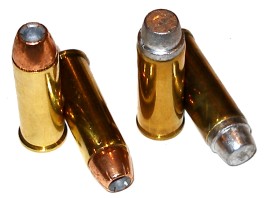 Timothy Treadwell learned the hard way, the meaning of the expression, “Sometimes you get the bear and sometimes the bear gets you”. Fishing in a remote area can get a little dicey when a dispute breaks out between fisherman and bear over the ownership of a prize salmon. Of course, 99.9% of the time animals can be observed and confrontations avoided, but that .1% chance that things can turn bad, demands contingency planning.
Timothy Treadwell learned the hard way, the meaning of the expression, “Sometimes you get the bear and sometimes the bear gets you”. Fishing in a remote area can get a little dicey when a dispute breaks out between fisherman and bear over the ownership of a prize salmon. Of course, 99.9% of the time animals can be observed and confrontations avoided, but that .1% chance that things can turn bad, demands contingency planning.
If wild animals aren’t a wilderness problem, unfortunately, humans can be. If criminals would invade a home in the middle of the day with police only fifteen minutes away, what do you think the code of conduct would be when you’re hours, if not days, away from assistance? If you’re going to be out on your own, and self reliance is required, the Ruger Redhawk is a good place to start. Where a .44 Magnum or .45 Colt with heavy loads would be too much for most concealed carry or even home defense situations in an urban or suburban setting, they are just about right for the noted broad self-defense applications. Big enough to stop a bear in a pinch, but not so big that they are too punishing to shoot and routinely practice.
For dedicated hunting pieces, Ruger makes Redhawks and Super Redhawks with longer barrels and in configurations to accommodate scope mounting for long range handgun hunting. However, in many places shots at deer, hogs and black bear are within 50 yards. I see no reason why either the 4″ .44 Magnum or 45 Colt couldn’t make for an excellent ultra light, compact firearm with a big thump for hunting season.
A double action preference…
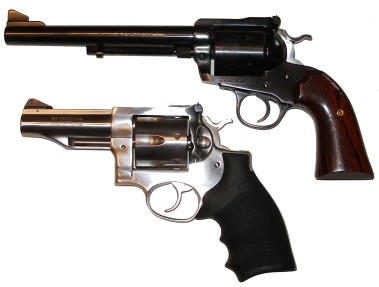 My choice has been single action revolvers for heavy magnum loads, more specifically, heavy framed Blackhawks in one form or another. I like the strength and simplicity of these single action revolvers; few parts to break, a cylinder in a fixed location and the ability to handle heavy handloads with ease. The drawbacks have been three miles of slow motion hammer fall and the need to cock the hammer before the gun would fire. Fortunately, neither circumstance applies to the Redhawk. The Redhawk is touted by Ruger as being up to snuff for magnum loads and it is ready to fire with the pull of its trigger. I believe the physical size of the Redhawk gives credence to this claim.
My choice has been single action revolvers for heavy magnum loads, more specifically, heavy framed Blackhawks in one form or another. I like the strength and simplicity of these single action revolvers; few parts to break, a cylinder in a fixed location and the ability to handle heavy handloads with ease. The drawbacks have been three miles of slow motion hammer fall and the need to cock the hammer before the gun would fire. Fortunately, neither circumstance applies to the Redhawk. The Redhawk is touted by Ruger as being up to snuff for magnum loads and it is ready to fire with the pull of its trigger. I believe the physical size of the Redhawk gives credence to this claim.
| Revolver | Caliber | Barrel Length |
Cylinder Diameter |
Cylinder Wall |
Cylinder Length |
Frame at Barrel |
Barrel Shank |
Weight |
| Redhawk | .45 Colt | 4.0″ | 1.780″ | 0.104″ | 1.750″ | 0.941″ | 0.680″ | 2 lbs 13 oz |
| Redhawk | .44 Mag | 4.0″ | 1.780″ | 0.115″ | 1.750″ | 0.963″ | 0.680″ | 2 lbs 14 oz |
| Bisley | .45 Colt | 7.5″ | 1.732″ | 0.088″ | 1.702″ | 0.890″ | 0.625″ | 3 lbs |
| Taurus 44 | .44 Mag | 4.0″ | 1.753″ | 0.085″ | 1.692″ | 0.910″ | 0.611″ | 2 lbs 13 oz |
Ruger kept the Redhawk’s overall weight down without sacrificing beef on the cylinder, frame and barrel where it is welcome, while providing more cylinder lock up points than typical, for a total of three; 1) center pin lock, 2) indexing pawl and 3) front latch. The dimensions indicated above were taken from examples of each gun. Minor variations amongst a population of Redhawks, such as frame at barrel width, are due to finishing variations and not differences in frame size specification.
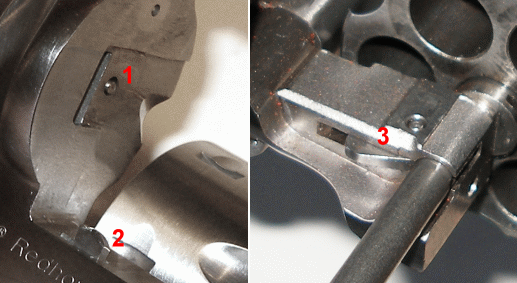
Ruger operates a sophisticated casting operation, doing lots of work for outside clients as well as for their own firearm production. There are virtually no manufacturers’ handguns sporting forged or billet parts anymore, so the defining issues become not if a gun contains cast parts, but rather the quality of castings, the preciseness of machined surfaces and the quality of parts fitting. Ruger clearly has a handle on investment casting; few gate marks, virtually no parting lines, no rough edges or pock marks from air, impurities or poorly managed process.
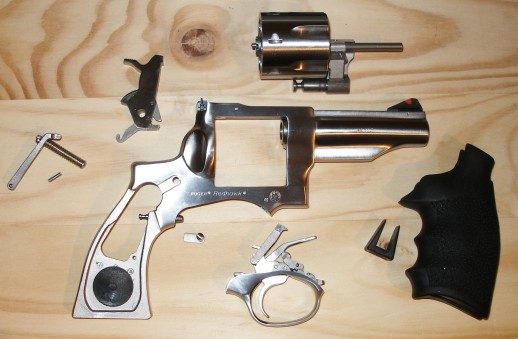
Outside of the cylinder, centering pin rod, locking latches, springs and a couple of pins, parts are cast then machined as required for fit. As an example, the cast trigger guard has received lots of secondary machining operations for a critical fit of trigger small parts and fit to the gun’s frame. Overall, a pretty slick assembly. Disassembly of the Redhawk is pretty straight forward. With no side plate, all of the parts pull out of the top or drop out of the bottom and there is only one coil spring, or mainspring that covers all sprung functions. If you’re used to the screw through the grip versions of Ruger products, the Hogue grip takes a little patience for removal and the use of the Hogue Bantam Tool. The little “U” shaped tool, to the left of the grip, is packed in with every new gun.
Sights I can see…
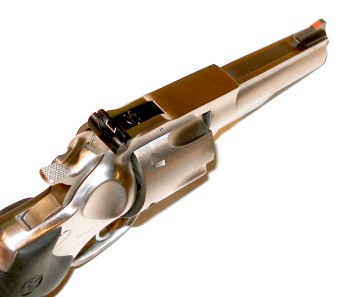 The combination of non-reflective ramped front sight and simple white outlined fully adjustable rear sight, with a nice grooved wide rib in between, works well. The sight radius, at roughly 5.800″, doesn’t seem short and the combination of front and rear sights is easy to hold steady on target.
The combination of non-reflective ramped front sight and simple white outlined fully adjustable rear sight, with a nice grooved wide rib in between, works well. The sight radius, at roughly 5.800″, doesn’t seem short and the combination of front and rear sights is easy to hold steady on target.
The 0.130″ wide front blade is retained with what Ruger refers to as a spring loaded plunger, or what I refer to as a roll pin, to make blade color changes an easy task. Its width makes for an excellent sight picture with the rear sight’s 0.140″ aperture. Rear sight elevation and windage adjustments are positive click type with an approximately 3 MOA increment adjustment.
 Front sight inserts can be purchased directly from Ruger or from Brownells at a substantial savings. A $13 set includes white, yellow, fluorescent red, and sky blue selections. Another option available from Brownells is a Marble Arms fiber optic front sight in green or orange, in a variety of heights. Basically, you support the ramp on the down side with a non-marring back up, i.e. short piece of soft pine, and tap the pin out left to right and reinstall the same way. I believe, for the most part, the sights as received from the factory, are the best sights for the gun and any of its applications.
Front sight inserts can be purchased directly from Ruger or from Brownells at a substantial savings. A $13 set includes white, yellow, fluorescent red, and sky blue selections. Another option available from Brownells is a Marble Arms fiber optic front sight in green or orange, in a variety of heights. Basically, you support the ramp on the down side with a non-marring back up, i.e. short piece of soft pine, and tap the pin out left to right and reinstall the same way. I believe, for the most part, the sights as received from the factory, are the best sights for the gun and any of its applications.
(Editor’s note: As indicated, the front sight blade on the two models represented are retained with a roll pin, rather than a quick change spring loaded plunger. Consequently, the reference to replacement blades is in error. These parts pertain to the spring loaded plunger retained sights and not to those secured with a roll pin. Thanks for the heads up Evan)
And then the blazing away began…
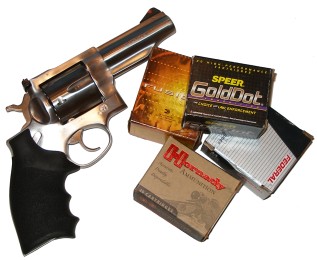 Part II of this project contains new handloads developed specifically for this project, however, I wanted to offer some representative live fire impressions of both guns. Neither gun exhibited roughness common to new firearms and, after some use, they felt just as tight and precise as they did when received. Statistically, both guns have the same average trigger pull, 10 lbs 3 oz double action and 6 lbs 4 oz single action.
Part II of this project contains new handloads developed specifically for this project, however, I wanted to offer some representative live fire impressions of both guns. Neither gun exhibited roughness common to new firearms and, after some use, they felt just as tight and precise as they did when received. Statistically, both guns have the same average trigger pull, 10 lbs 3 oz double action and 6 lbs 4 oz single action.
The Ruger Redhawk is easy to shoot in double as well as single action; none of the typical knuckle busting, hand web hammer biting, or stinging sensations associated with relatively light revolvers and stiff loads. Neat!
Both the .44 Mag and .45 Colt revolvers felt very balanced with the 4″ barrel. That’s actually a big deal for me. I couldn’t hit a barn with a shorter barrel snub nose because that type of barrel has too little mass to hold steady. My 7 1/2″ barrel Ruger Bisleyis at odds with gravity and the front sight wants to always dip below the horizon if it’s held out there for too long. The 4″ barrel Redhawk works well for me; long enough and hefty enough to be rock steady, but without feeling muzzle heavy.
The 44 Magnum – Port whine…
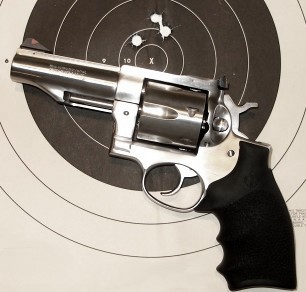 A 3 shot 25 yard group that measures only 1¼” and, yes, it was absolutely hand picked from the pile. The tiny group came from 180 grain HornadyCustom JHP/XTP ammo and a two hand hold over a rest. All of the factory ammo shot under 2½” and I am not a very good shot.
A 3 shot 25 yard group that measures only 1¼” and, yes, it was absolutely hand picked from the pile. The tiny group came from 180 grain HornadyCustom JHP/XTP ammo and a two hand hold over a rest. All of the factory ammo shot under 2½” and I am not a very good shot.
I had the opportunity to compare the factory ammo chronograph results from the Redhawk with data I had logged awhile back with another gun I like, theTaurus 44SS4. Both 4″ barrel guns, I wanted to measure the ballistic influence of the 1″ of porting and integral expansion chamber present on the Taurus barrel. Essentially, the last inch of the Taurus is unrifled, slightly over caliber and filled with holes that direct gases out to either side of the gun’s front sight. I think the difference is significant, especially when some relatively minor increases in heavy bullet velocity can yield major kinetic energy improvements.
| Ammo | Bullet Weight | Redhawk Velocity | Taurus Velocity | Velocity +/- |
| Federal Classic | 180 | 1482 | 1447 | 35 |
| Federal Fusion | 240 | 1357 | 1246 | 111 |
| Hornady Custom | 180 | 1584 | 1524 | 60 |
| Precision Cartridge | 185 | 1360 | 1301 | 59 |
| Speer Gold Dot | 270 | 1202 | 1097 | 105 |
Much like my Marlin .45-70 Guide Gun, the Taurus porting makes for sensational low light level shooting with the potential for singed eyebrows, but does little to reduce recoil or muzzle jump. In the case of the Taurus, there is the penalty of carrying a gun with the external dimensions of a 4″ barreled gun, but with the performance of a 3″ stubby. Magnum case capacity benefits significantly from a little more active barrel length and powder is why we shoot them.
The .45 Colt…
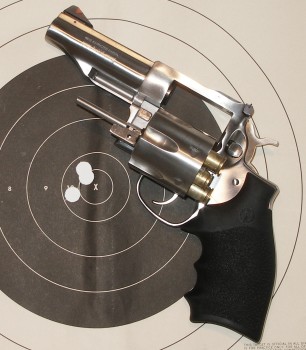 The problem I had with the .45 Colt version of the Redhawk was putting it down. A handload I frequently shoot with the single action Ruger is a 255 grain cast SWC over 24 grains of W296 and a magnum pistol primer. Clearly it agreed with the Redhawk as well. Average velocity from the 4″ barrel was 1327 fps and accuracy and shot to shot consistency were outstanding. The group size pictured right was the best of the best at ¾”, but holding group sized below 1¾” when shooting from a rest was not a chore.
The problem I had with the .45 Colt version of the Redhawk was putting it down. A handload I frequently shoot with the single action Ruger is a 255 grain cast SWC over 24 grains of W296 and a magnum pistol primer. Clearly it agreed with the Redhawk as well. Average velocity from the 4″ barrel was 1327 fps and accuracy and shot to shot consistency were outstanding. The group size pictured right was the best of the best at ¾”, but holding group sized below 1¾” when shooting from a rest was not a chore.
There are probably a multitude of reasons for the .45 Colt Redhawk being a great shooter. Besides the contribution of mechanical preciseness to accuracy, the grip angle is much better than that of a traditional single action revolver.,making the gun comfortable to shoot and natural to point. Additionally the gun felt very balanced and the sights were easy to hold on target. With a little patience, shooting double action was as easy to shoot as single action. The Redhawk in .45 Colt is a gun that can be carried with confidence .
Preliminary conclusions…
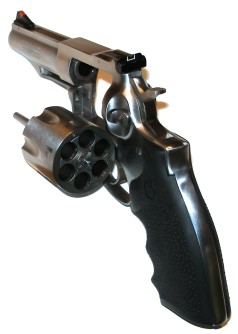 I wish I had some great and original insight to offer on the Redhawk at this juncture. I do not. The guns are typical of the company that makes them; excellent quality, good shooters, stronger than they need to be. Both guns are accurate, I find the .45 Colt easier to shoot, but that may be my personal preference.
I wish I had some great and original insight to offer on the Redhawk at this juncture. I do not. The guns are typical of the company that makes them; excellent quality, good shooters, stronger than they need to be. Both guns are accurate, I find the .45 Colt easier to shoot, but that may be my personal preference.
I have a large pile of components, the Folgers’ Ballistic Tester is warmed up and ready to go and I suspect I will learn a lot more about these guns and their performance over the next few days. I have .44 magnum loads from 180 grains to 300 grains and .45 Colt loads up to 360 grains. There is a mixture of cast and jacketed bullets.
Both guns have a retail price of $836 and, as is the case with virtually all guns, a lesser street price. Considering the quality of these guns at $150 – $200 less than comparable 625 and 629 S&W models, they are a major value. Compared to the autoloaders I shoot with some frequency, these big revolvers are a lot more interesting. I believe I need to locate a nice field carry holster.
Additional related information:
Ruger Redhawks – A Case of Sibling Rivalry 44 Magnum and 45 Colt – Wilderness Protection
Handloading the .44 Remington Magnum and .45 Colt Ruger Redhawks – You can’t buy just one.

Email Notification